
Why Crystal Fertilizers? Features and Benefits of Crystal Fertilizers
Crystal fertilizers represent one of the most innovative and efficient forms of fertilizers used in modern agriculture and horticulture. These fertilizers stand out due to their fine granular structure and crystalline composition, which allows them to dissolve rapidly in water, delivering essential nutrients to plants in the shortest possible time. Many fertilizers are produced in crystal form, with some of the most common examples including ammonium sulfate, potassium sulfate, iron sulfate, and others. In this comprehensive article, we’ll introduce crystal fertilizers in detail, delve into their key features, highlight their numerous advantages, and discuss their practical applications. Stick with us as we unpack everything you need to know to make informed decisions about incorporating these fertilizers into your farming or gardening practices.
Introducing Crystal Fertilizers
Agricultural fertilizers come in a variety of forms, such as liquid, crystal, granular, and powder. Each type has its own set of pros and cons, tailored to different needs and scenarios. We’ve previously covered the characteristics of granular fertilizers in depth in another article, and we highly recommend checking it out for a well-rounded understanding. However, today’s focus is squarely on crystal fertilizers, which offer unique benefits that set them apart from the rest.
Crystal fertilizers are manufactured as transparent, fine crystals that resemble small, shimmering gems. Their defining trait is their high solubility in water, enabling nutrients to become immediately available to plants upon application. This quick-action property makes them particularly favored by farmers during the early stages of plant and tree growth, when rapid nutrient uptake can make a significant difference in establishing strong roots and healthy development.
These fertilizers can contain a wide range of nutrient compounds, including nitrogen-based, phosphate-based, potassium-based elements, and more. For instance, ammonium sulfate, which provides essential nitrogen and sulfur for trees and crops, is often produced in crystal form. Essentially, fertilizer manufacturers have the flexibility to formulate plant-required nutrients into crystal structures, allowing for customized solutions that address specific deficiencies in soil or crops.
Crystal Fertilizer Usage
Crystal fertilizers find widespread use in cultivating various agricultural products, from orchards to fields. Some of the primary applications include:
Fruit trees, where they support robust blooming and fruit set. Vegetables and produce like tomatoes, cucumbers, and leafy greens. Field crops such as wheat, barley, corn, and similar staples. Greenhouse-grown items, benefiting from controlled nutrient delivery. Turf grass and ornamental landscaping in parks and gardens. And virtually any other crop or plant in agricultural settings.

Key Point: Crystal fertilizers garner attention from farmers because of their superior solubility and easy absorption by plants, leading to faster results and healthier growth.
Advantages of Using Crystal Fertilizers in Agriculture
As one of the most popular fertilizer types in farming today, crystal fertilizers boast a multitude of benefits that enhance productivity and sustainability. Let’s break them down in detail:
Rapid Dissolution
A standout feature of crystal fertilizers is their ability to dissolve quickly in water. This means nutrients are released almost instantly, making them readily available for plant uptake. Unlike slower-releasing options, this quick solubility ensures that plants don’t have to wait for essential elements, which is crucial during periods of high demand.
Enhanced Nutrient Absorption
Thanks to their fast-dissolving nature, crystal fertilizers facilitate easier absorption by plant roots. This efficiency allows plants to utilize nutrients more effectively, promoting faster growth rates and better overall health. In essence, it’s like giving your crops a direct nutrient boost without the delays associated with other forms. We suggest you take a look at our guide to fertilizer absorption time.
Diverse Formulations
Crystal fertilizers come in various compositions, including single-element (like nitrogen-only), dual-element, or multi-element blends. Examples include nitrogen-rich, potassium-rich, or iron-based crystals. This variety enables farmers to select precisely what their soil or plants need, whether it’s correcting a micronutrient deficiency or balancing macronutrients.
Stability
The chemical structure of crystal fertilizers provides excellent stability, allowing them to perform well under diverse weather conditions and soil types. They resist degradation from environmental factors like rain or temperature fluctuations, ensuring consistent nutrient delivery over time.
Boosted Plant Performance
By supplying the exact nutrients plants crave, crystal fertilizers can significantly increase yield and improve product quality. Crops treated with these fertilizers often exhibit larger fruits, more vibrant colors, and higher nutritional value, translating to better market prices and consumer satisfaction.
Compatibility with Drip Irrigation or Foliar Spraying
Due to their high solubility and specialized formulations, crystal fertilizers are ideal for use in drip irrigation systems or as foliar sprays. When dissolved in water, they integrate seamlessly into irrigation lines, delivering nutrients straight to the root zone. This is especially beneficial during critical growth phases when plants require immediate nourishment, preventing stress and promoting vitality.
Minimized Fertilizer Waste
Applying crystal fertilizers via drip irrigation directs nutrients precisely to the plant roots, reducing runoff and leaching. This targeted approach not only conserves resources but also minimizes environmental impact, such as preventing nutrient pollution in waterways, a growing concern in sustainable agriculture.
Suitability for Sensitive Plants
Crystal fertilizers are particularly well-suited for delicate crops like vegetables, which can be easily overwhelmed by harsher fertilizer types. Their gentle, quick-absorbing formula ensures that even finicky plants receive balanced nutrition without the risk of burn or overload.
Mixability with Other Fertilizers
Most crystal fertilizers can be combined with one another, giving farmers the freedom to create custom blends tailored to specific plant needs. Of course, it’s essential to know which combinations are compatible to avoid chemical reactions that could reduce efficacy. Consulting fertilizers compatibility charts or experts is always a smart move.
Soil Structure Improvement
With their high solubility, crystal fertilizers contribute to better soil health by releasing nutrients evenly and quickly. This can enhance soil aeration, improve water retention, and facilitate root penetration. Over time, healthier soil leads to more resilient plants and reduced erosion, fostering long-term agricultural sustainability.
Given these advantages, incorporating crystal fertilizers into your routine can empower farmers and gardeners to achieve superior results, from higher yields to more robust plants. They represent a smart investment in efficiency and environmental stewardship.

Key Point: If your plants are sensitive or in their early growth stages, crystal fertilizers are an superior choice due to their rapid dissolution and effortless absorption, minimizing stress and maximizing potential.
Methods for Applying Crystal Fertilizers
Applying crystal fertilizers can be done through several versatile methods, each suited to different scenarios. Here’s a closer look:
- Foliar Spraying: This involves mixing the crystal fertilizer with water to create a solution, then spraying it directly onto the plant leaves. It’s highly effective for quick nutrient absorption, especially when plants show signs of deficiency. The leaves act as a direct entry point, bypassing soil issues and delivering relief fast, ideal for emergency interventions during nutrient shortages.
- Fertigation (Irrigation Feeding): Here, the fertilizer is added to irrigation water, allowing it to reach the roots alongside hydration. This method shines in drip irrigation setups, where nutrients are delivered precisely without waste. It ensures even distribution throughout the soil, providing ongoing nourishment that supports steady growth.
- Direct Soil Application: For this, dissolve the crystals in water and pour the solution around the plant base. It’s straightforward and perfect for potted plants or small garden beds, where targeted feeding is key.
- Soil Mixing: Typically used during land preparation before planting, this method involves thoroughly blending the crystal fertilizer into the soil. It sets the stage for uniform nutrient availability from the start, promoting strong establishment.
Choosing the right application method depends on factors like plant type, growth stage, soil conditions, and irrigation infrastructure. For optimal outcomes, consult agricultural experts who can tailor recommendations to your specific setup.
Comparing Crystal Fertilizers to Granular Fertilizers

To better appreciate crystal fertilizers, let’s compare them side-by-side with granular ones, using ammonium sulfate as an example:
| Feature | Ammonium Sulfate Crystal Fertilizer | Ammonium Sulfate Granular Fertilizer |
|---|---|---|
| Appearance | Transparent, shiny crystals | Small, dense granules |
| Solubility in Water | Dissolves rapidly | Dissolves gradually and evenly |
| Plant Absorption | Quick uptake | Steady, prolonged absorption |
| Stability | Less stable in varying conditions | More stable and long-lasting in soil |
| Applications | Ideal for sensitive plants and early growth | Suited for large fields and season-long feeding |
| Usage Method | Often via irrigation | Mixed directly into soil |
This comparison highlights how crystal forms excel in speed and precision, while granular options offer durability for extended release.
Determining the Right Amount of Crystal Fertilizer
Proper dosing is critical with crystal fertilizers to meet plant needs without harm. Over-application can damage plants and pollute the environment, while under-dosing yields suboptimal growth. Key factors influencing dosage include:
- Plant Type: Different crops have varying nutrient demands. Staples like wheat and barley often require more, followed by vegetables and fruits, with ornamentals needing the least.
- Soil Requirements: Soil testing is indispensable to gauge nutrient levels, pH, and deficiencies. It provides a roadmap for precise fertilization.
- Plant Age: Young plants demand more nutrients for development, whereas mature ones may need less to maintain health.
- Soil Texture: Sandy, light soils retain nutrients poorly, necessitating higher doses, unlike clay-heavy soils that hold onto elements longer.
- Environmental Conditions: Temperature, humidity, and rainfall affect nutrient needs. Favorable weather might reduce requirements, while harsh conditions could increase them.
By considering these and conducting soil tests, you can accurately calculate dosages for optimal growth. If you’re new to this, seek advice from experienced farmers or agronomists.
Timing for Crystal Fertilizer Application
Apply crystal fertilizers at these strategic times:
- Planting Stage: Use them during seeding or transplanting to supply initial nutrients for strong starts.
- Active Growth Period: This encompasses germination, leaf development, and flowering. Plants crave nutrients here, so fertigation with crystals ensures timely support.
- Avoid post-harvest applications; instead, opt for organic or granular fertilizers to prep soil for winter.
Essential Tips for Buying High-Quality Crystal Fertilizers
Quality is paramount for effective fertilization. When shopping for crystal fertilizers, keep these in mind:
Choose reputable brands with official certifications. Look for clear, clump-free crystals. Ensure complete solubility without residue. Verify appropriate chemical composition. Confirm nutrient percentages match labels. Check expiration dates.

One top crystal fertilizer is ammonium sulfate crystals, widely used for lush, ideal growth. If you’re in the market, consider buying Barno ammonium sulfate crystals from Barsava Sepehr Part brand. This high-grade product is produced by a company active in both domestic sales and exports to various countries, aiming to build a global reputation. With such credentials, Barsava Sepehr Part is a reliable choice for premium ammonium sulfate crystals.
Expanding on the Broader Impact of Crystal Fertilizers in Modern Farming
To reach a deeper understanding, let’s explore how crystal fertilizers fit into the larger landscape of sustainable agriculture. Crystal fertilizers’ precision delivery systems align perfectly with precision agriculture techniques, where data-driven decisions; such as soil sensors and drone mapping; guide nutrient applications. This minimizes overuse, reduces costs for farmers, and lessens the ecological footprint by curbing excess runoff that could lead to algal blooms in nearby water bodies.
Moreover, crystal fertilizers support integrated pest management (IPM) by bolstering plant health, making crops more resistant to diseases and pests. Healthier plants mean fewer chemical interventions, promoting biodiversity on farms. For organic-leaning operations, while not always certified organic, crystal forms derived from natural sources can bridge the gap, offering a semi-synthetic option that’s still eco-friendly.
In greenhouse settings, where controlled environments demand exact nutrient control, crystal fertilizers excel. They dissolve cleanly, preventing clogs in hydroponic or aeroponic systems, and allow for fine-tuned pH adjustments. This is crucial for high-value crops like strawberries or herbs, where even minor imbalances can affect flavor and yield.
Economically, adopting crystal fertilizers can lead to substantial savings. Their efficiency means less product is needed overall, and faster growth cycles can shorten time-to-market, boosting profitability. For small-scale farmers or urban gardeners, the ease of use, mixing small batches for foliar sprays, democratizes access to professional-grade results without heavy machinery.
Challenges and Considerations
No fertilizer is perfect, and crystal ones have caveats. Their rapid release can lead to leaching in heavy rains if not timed right, so monitoring weather is key. Storage is another factor; keep them in dry, cool places to prevent caking. Always wear protective gear during handling to avoid skin irritation from concentrated forms.
In conclusion, crystal fertilizers offer a versatile, effective solution for modern agricultural needs. By understanding their features, advantages, and best practices, you can harness their power for thriving crops and sustainable farming. Whether you’re a seasoned farmer or a backyard enthusiast, integrating them thoughtfully can yield impressive results.
